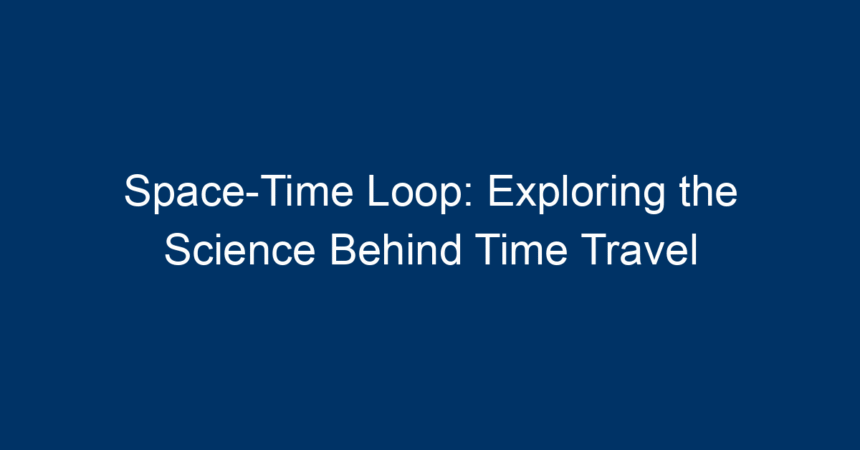Introduction
Imagine a world where time is not a linear path but a complex web of interwoven moments, where the past, present, and future coexist. Welcome to the concept of a space-time loop, a fascinating idea that fuels the imagination of scientists and science fiction enthusiasts alike. Time travel, while often relegated to the realm of fantasy, has deep roots in theoretical physics, and the space-time loop is at the heart of this intriguing exploration. In this article, we will delve into the science behind space-time loops, explore their implications for time travel, and examine the theories that challenge our understanding of the universe.
Understanding Space-Time
Before diving into space-time loops, it’s crucial to grasp the fundamentals of space-time itself. Proposed by Albert Einstein in his theory of relativity, space-time combines the three dimensions of space with the dimension of time into a single four-dimensional continuum. This revolutionary idea fundamentally changed how we perceive gravity and the motion of objects.
The Fabric of Space-Time
Einstein’s equations describe how massive objects like planets and stars warp the fabric of space-time around them. This curvature explains the phenomenon of gravity, where objects follow the contours of this warped space-time, resulting in the orbits of planets and the falling of apples from trees.
Space-Time Continuum and Time Perception
In everyday life, we perceive time as a continuous, flowing river from past to future. However, the concepts of both time and space are more malleable than we once believed. Under specific conditions, particularly when approaching the speed of light or within strong gravitational fields, time can behave oddly—something Einstein captured with his theories.
Introducing Space-Time Loops
Now, let’s explore the heart of our discussion: space-time loops. A space-time loop, also known as a closed time-like curve (CTC), exists when a path through space-time brings an object back to its own past. This concept poses thought-provoking questions and paradoxes surrounding the nature of causality and the linear flow of time.
Theoretical Basis for Space-Time Loops
Space-time loops arise from solutions to Einstein’s equations. The most famous example is the Gödel Metric, proposed by the mathematician Kurt Gödel in 1949. Gödel’s solution introduced the idea that if the universe rotated on a grand scale, it could allow for circular time, where one could return to their past at certain points.
Cosmic Strings and Space-Time Loops
Another fascinating concept that ties to the creation of space-time loops is that of cosmic strings. These theoretical one-dimensional defects in the fabric of space-time might warp it sufficiently to allow time travel. By moving faster than the speed of light along a cosmic string, one could hypothetically create a time loop, allowing travel to the past.
Implications of Time Travel through Space-Time Loops
The implications of space-time loops extend beyond theoretical physics; they resonate through philosophy, ethics, and our understanding of reality itself.
Causality and Paradoxes
One of the most significant concerns associated with space-time loops is the potential for paradoxes. The grandfather paradox is a classic example: What happens if one travels back in time and prevents their grandfather from meeting their grandmother? Such scenarios challenge our notions of causality—how can an effect precede its cause?
Philosophical Considerations
Time travel also raises profound philosophical questions. Does the existence of a space-time loop imply that all events are predetermined? If one can change the past, what does that say about the nature of free will? The discussion around these questions continues to intrigue philosophers and scientists alike.
Current Scientific Research
While still within the realm of theoretical physics, researchers are actively exploring the possibility of creating and manipulating space-time loops. Over recent years, advancements in our understanding of quantum mechanics and gravitational physics have rekindled interest in time travel.
Quantum Mechanics and Time Travel
Quantum theories suggest that particles do not adhere to the same linear pathways as larger objects. Some interpretations, such as the many-worlds interpretation, propose the existence of parallel universes where different timelines coexist. In these models, the effects of a time traveler’s actions could branch off into alternate realities, sidestepping paradoxical scenarios.
Experimental Approaches
In the laboratory, researchers are beginning to test theories related to space-time loops. Although time travel remains a distant possibility, experiments with particle accelerators are allowing scientists to explore conditions that mimic some aspects of these complex phenomena. These cutting-edge studies seek to uncover the underlying principles of space-time.
Popular Culture and Space-Time Loops
The concept of space-time loops has permeated popular culture, often depicted in films, television shows, and literature. From "Back to the Future" to "Doctor Who," these narratives engage with the notion of time travel, sparking public imagination and interest in the scientific underpinnings of time.
Impact on Science Fiction
Science fiction often uses space-time loops as a plot device to examine human experience and ethical dilemmas. These narratives not only entertain but also serve to educate audiences about the complex realities of time travel theories. This intersection between science and storytelling fosters greater understanding and curiosity surrounding physics.
Concluding Thoughts
The exploration of space-time loops offers a tantalizing glimpse into the possibilities of time travel and the complexities of our universe. Though deeply rooted in theoretical physics, the implications stretch into philosophy, ethics, and popular culture. As research continues, our understanding of space-time and its potential for creating loops may evolve, perhaps unlocking the secrets of traveling through time.
Actionable Insights
-
Stay Informed: Keep abreast of new discoveries in theoretical physics and advancements in quantum mechanics. Reading scientific journals can provide insights into recent studies on space-time.
-
Engage with Philosophy: Explore philosophical discussions around time travel, causality, and free will, which can enhance your understanding of the implications of space-time loops.
- Participate in Educational Discussions: Join forums or attend talks on cosmology and theoretical physics to engage with experts and enthusiasts who share your interest in this captivating topic.
Final Thoughts
The journey into the wonders of space-time loops is just beginning. As we expand our understanding of the universe, we may find new paths to knowledge and perhaps, one day, even time travel itself. Embrace the mystery and let your curiosity guide you through the realms of science and philosophy.




